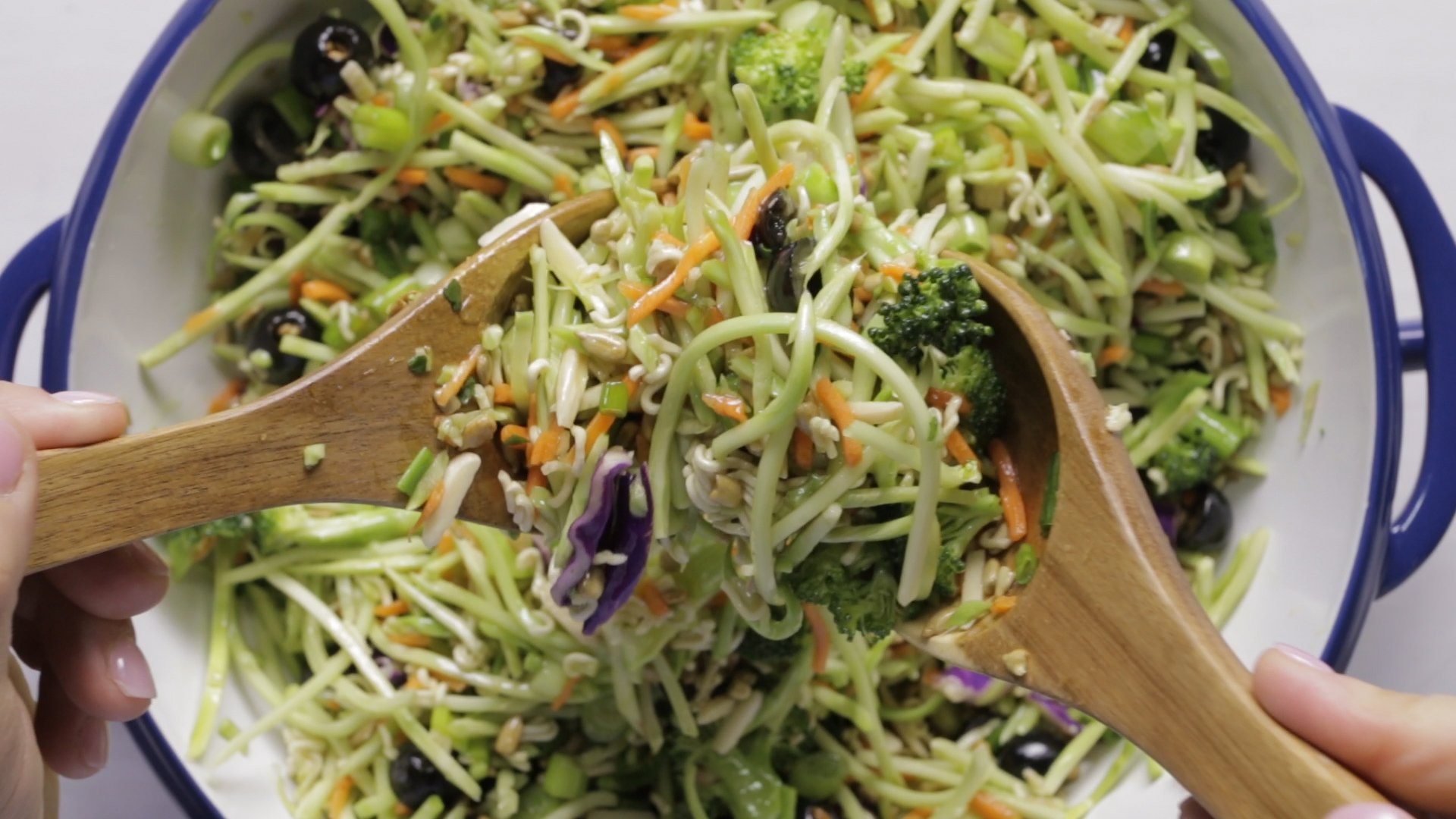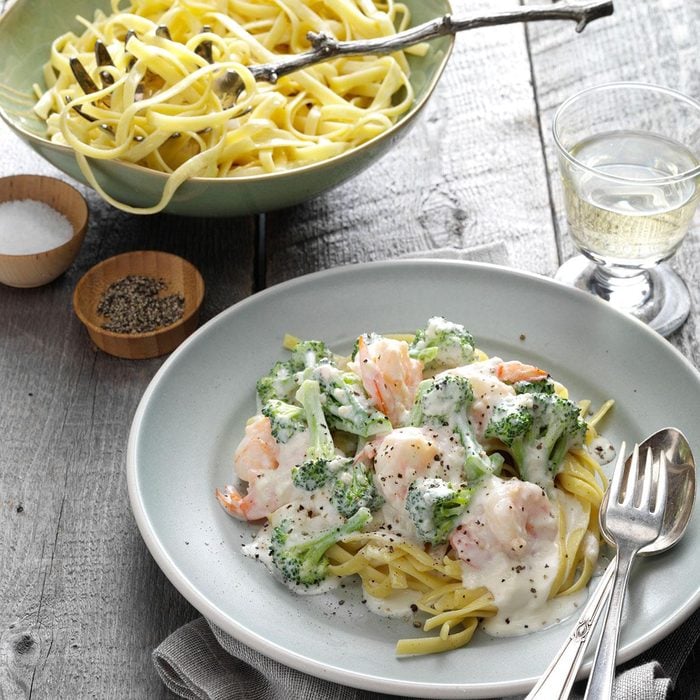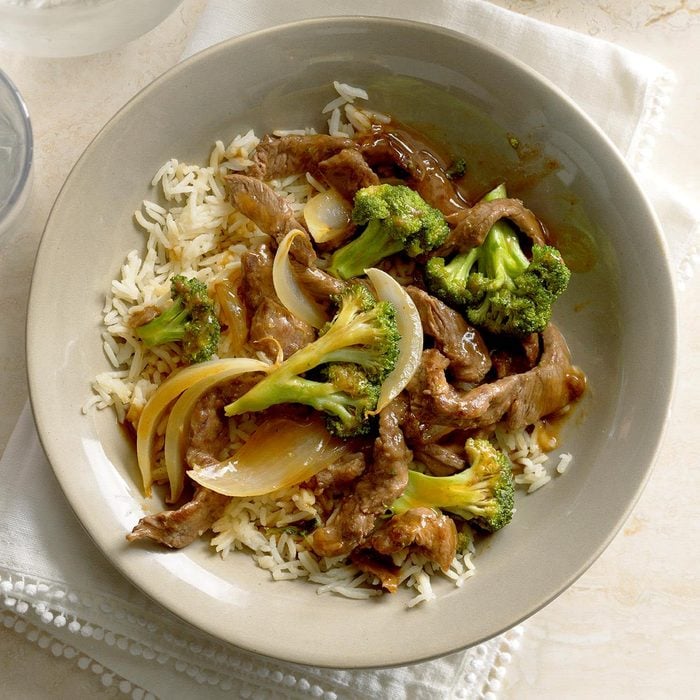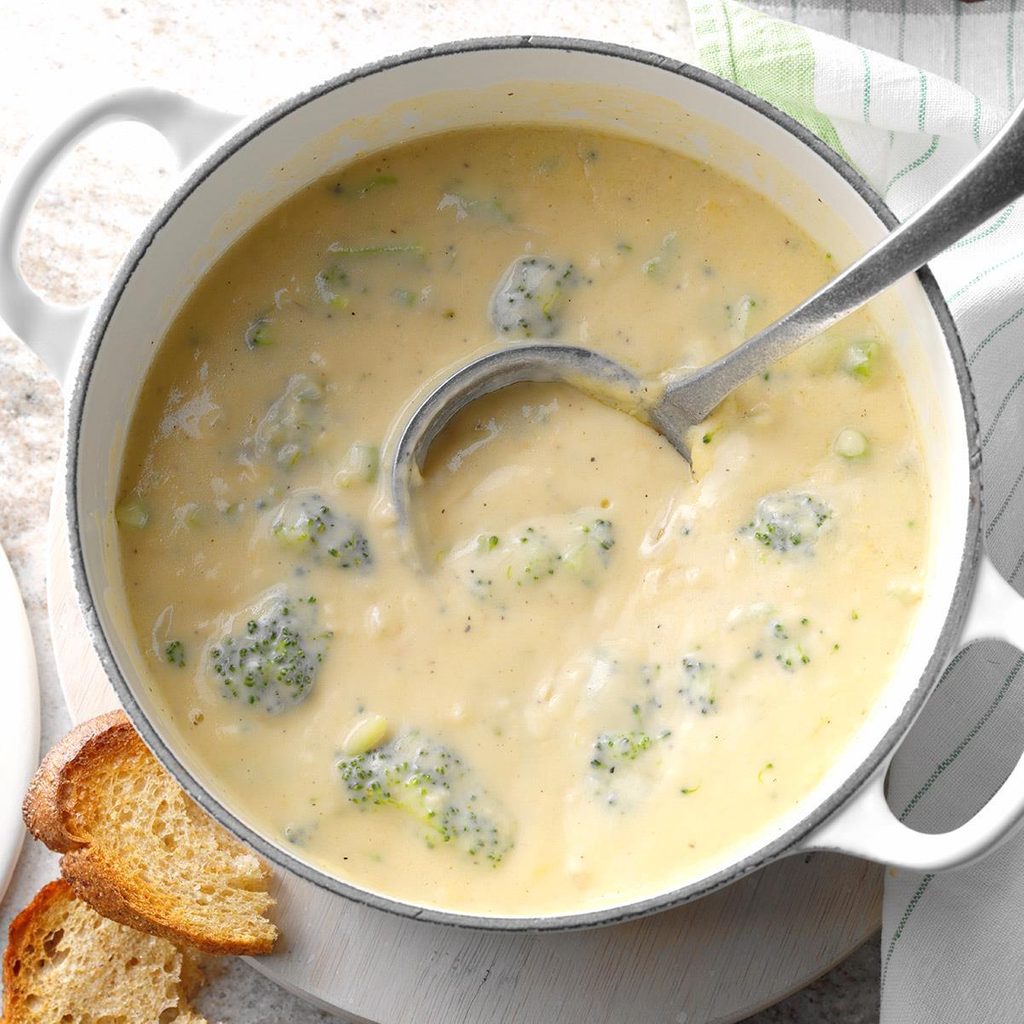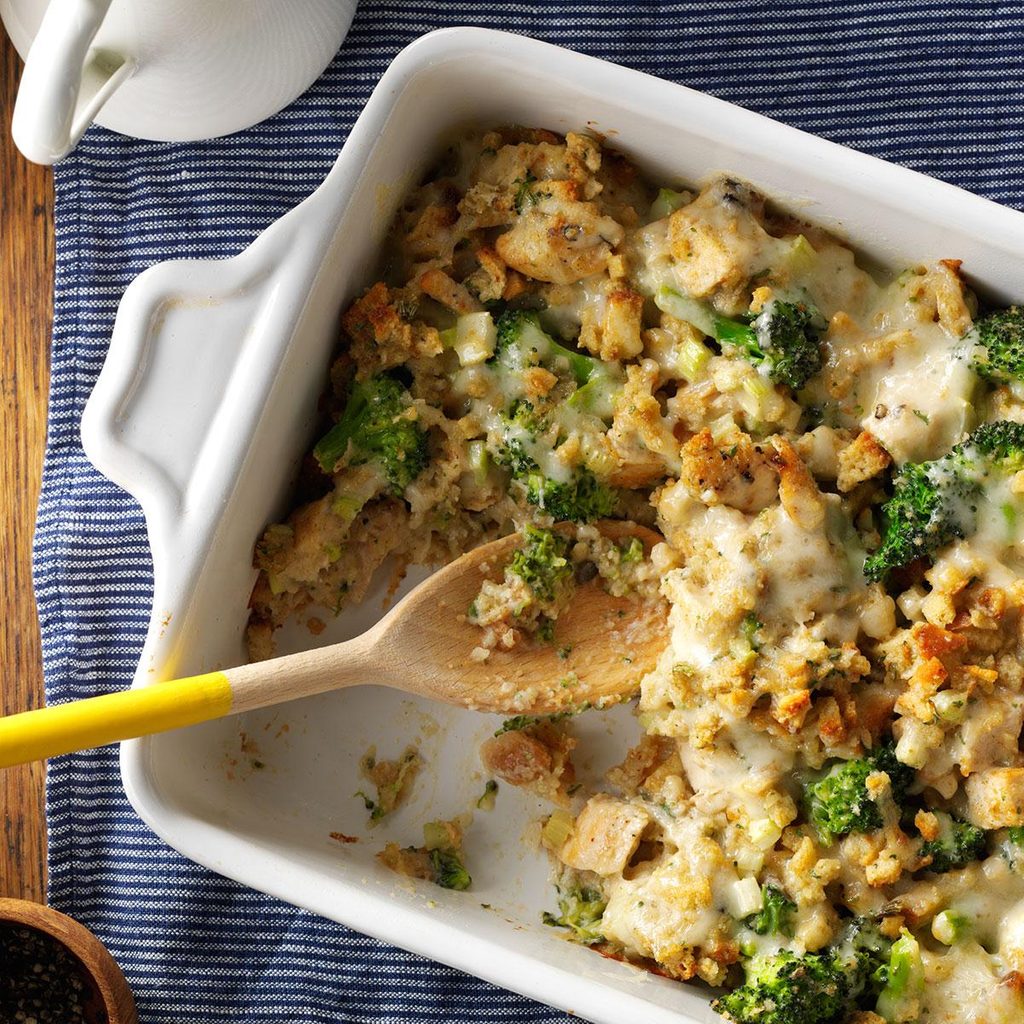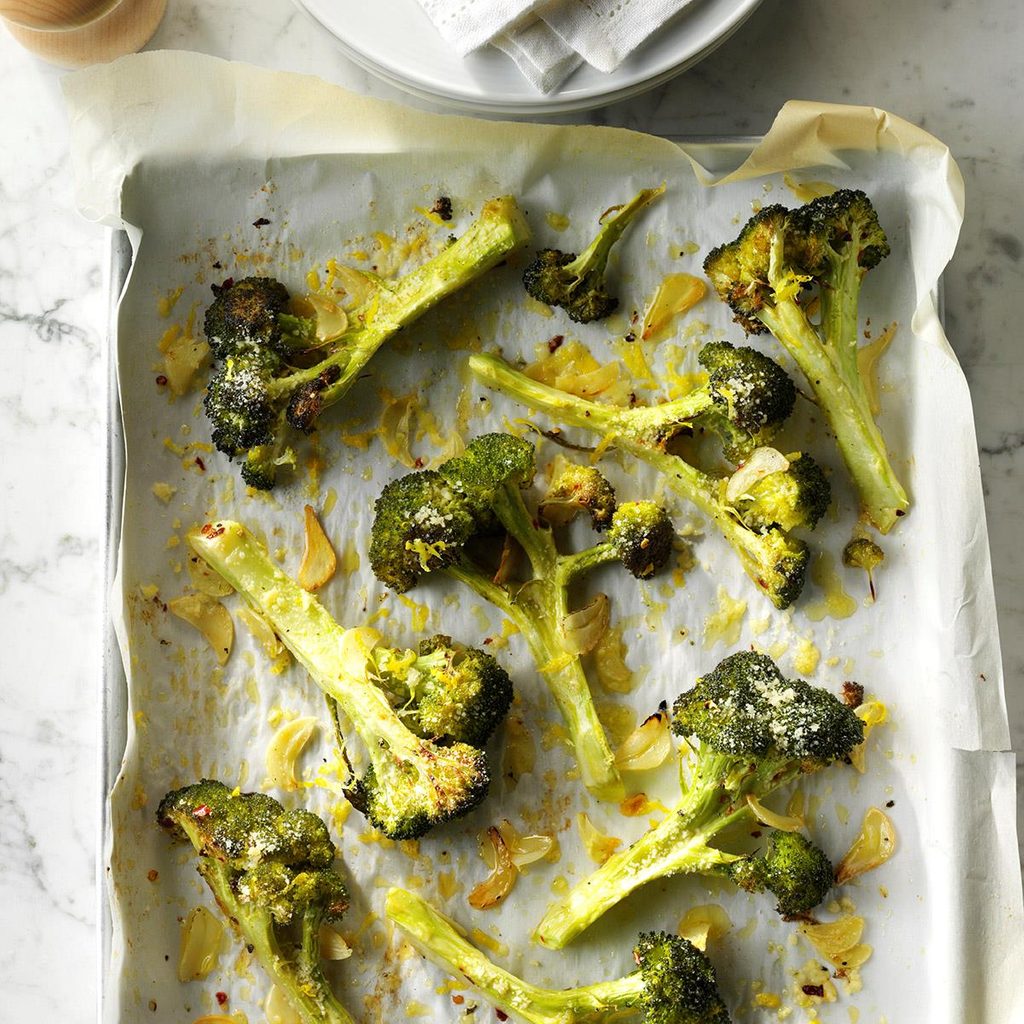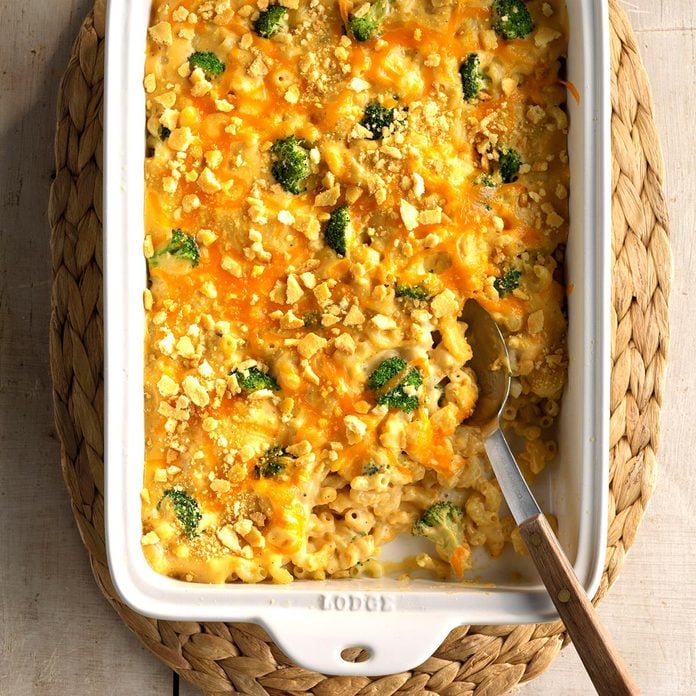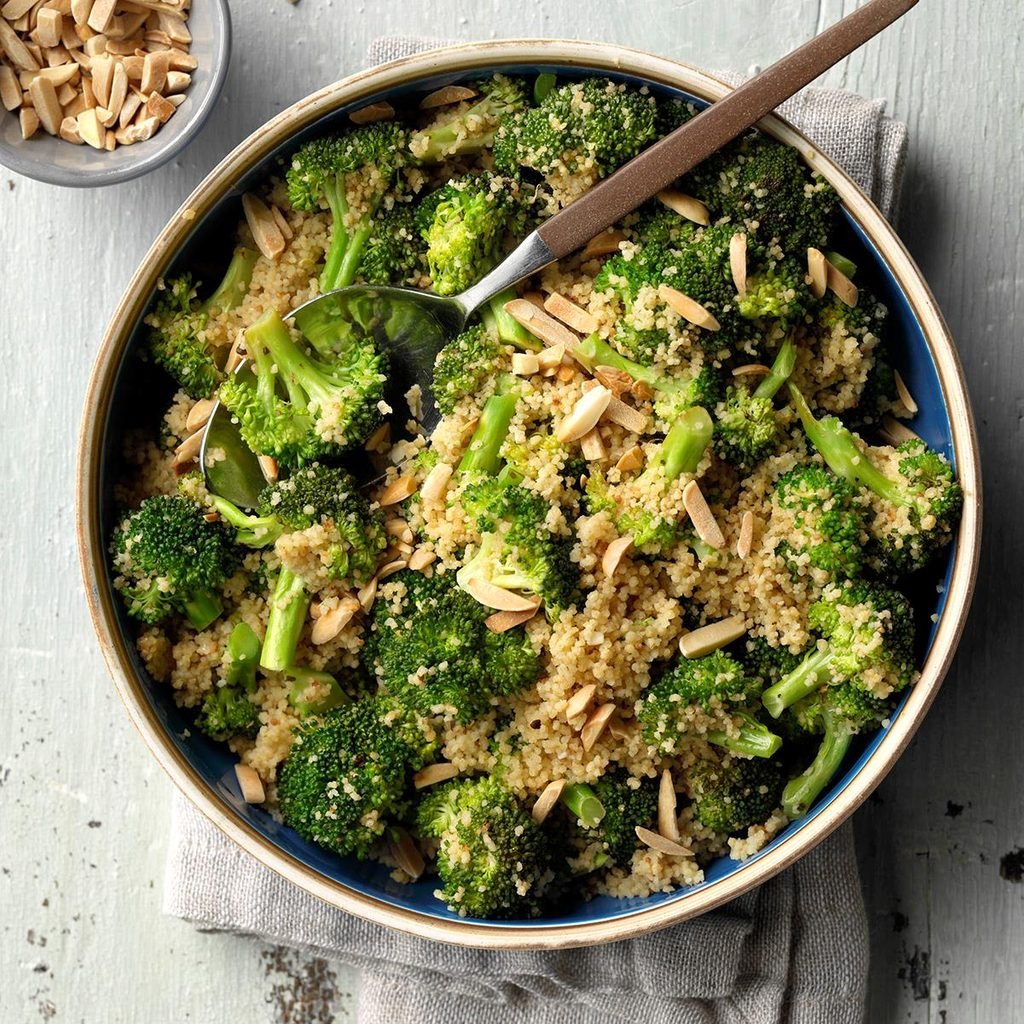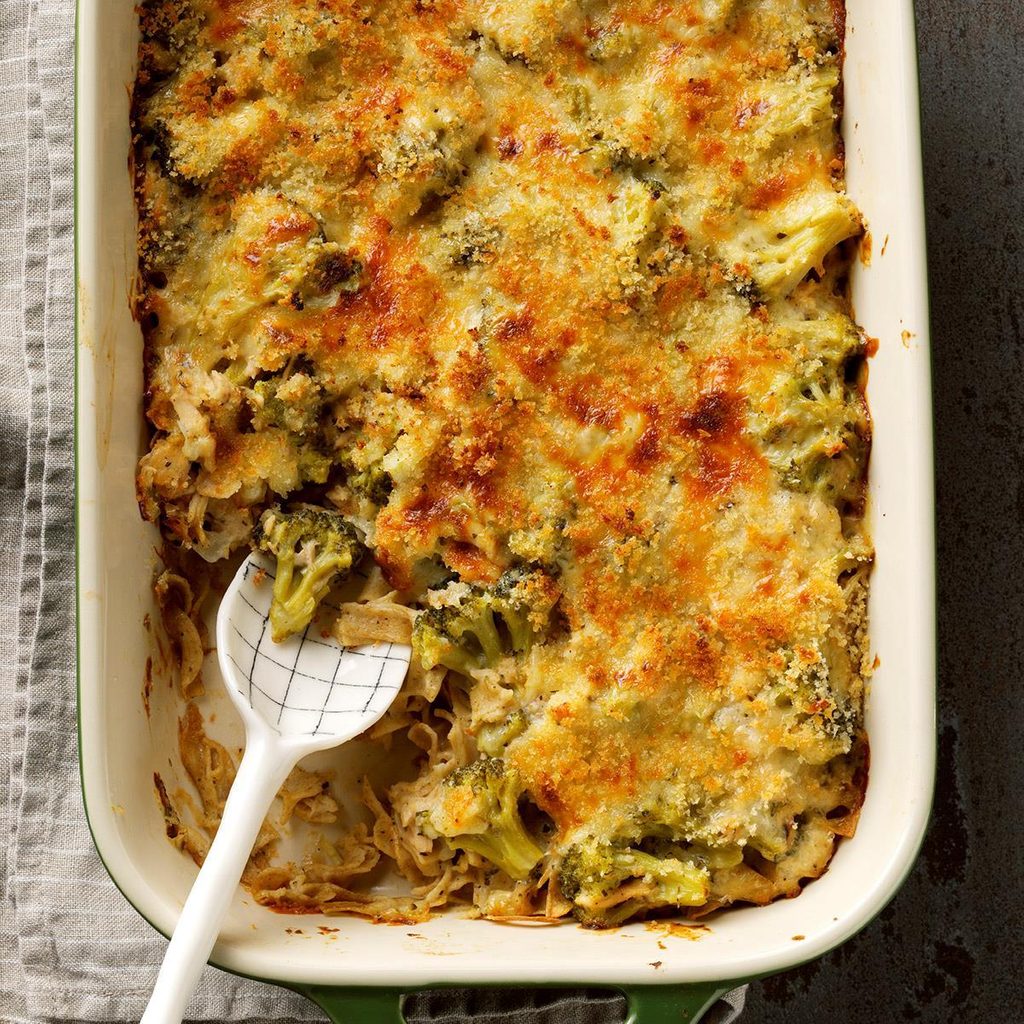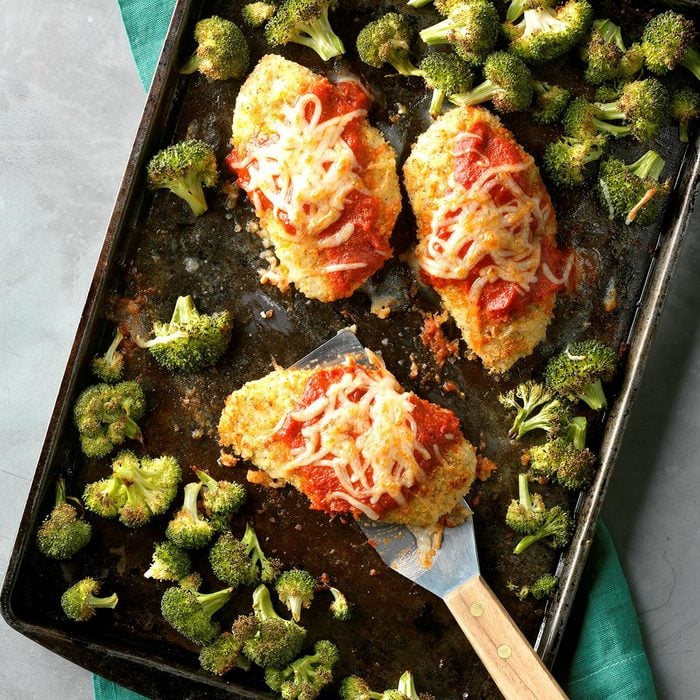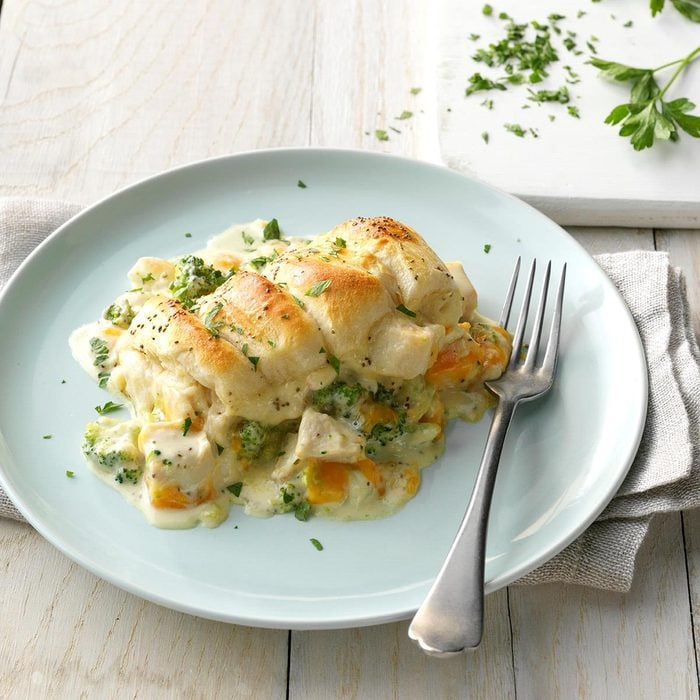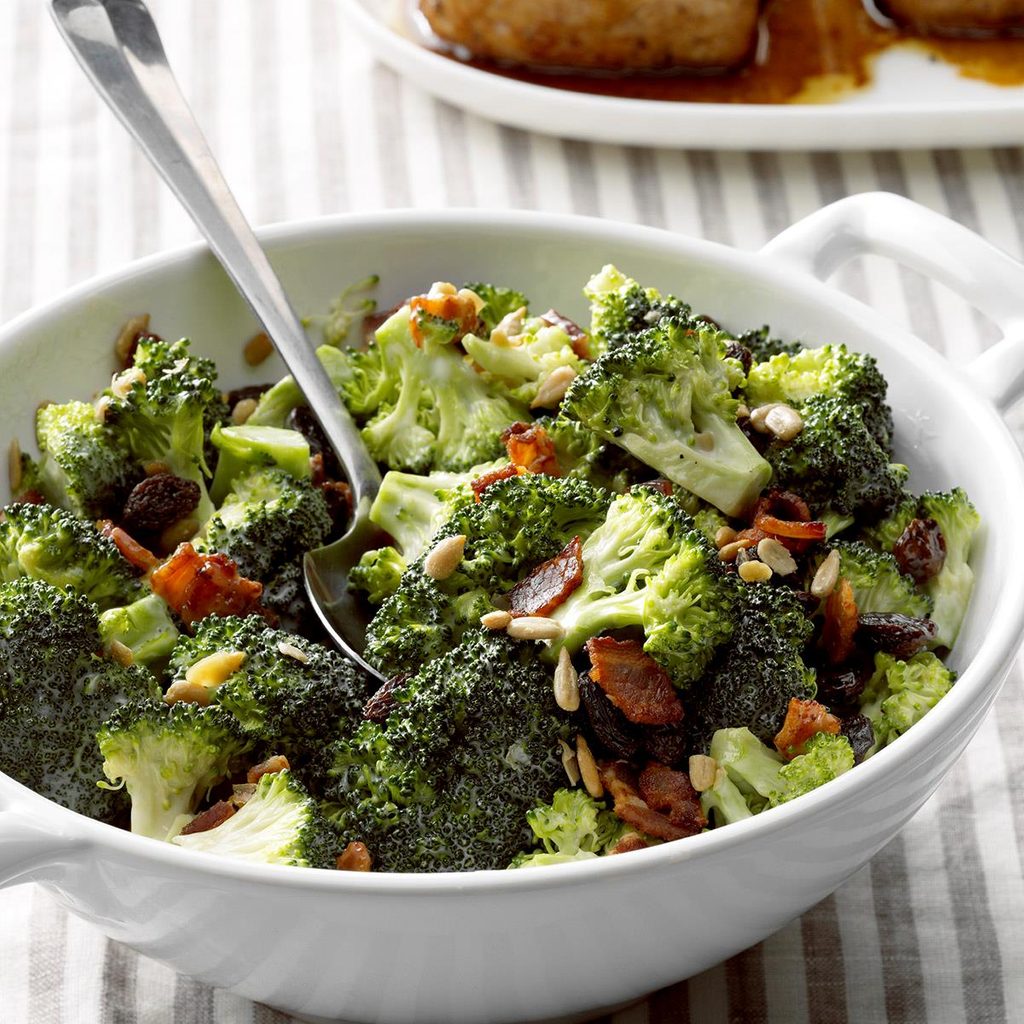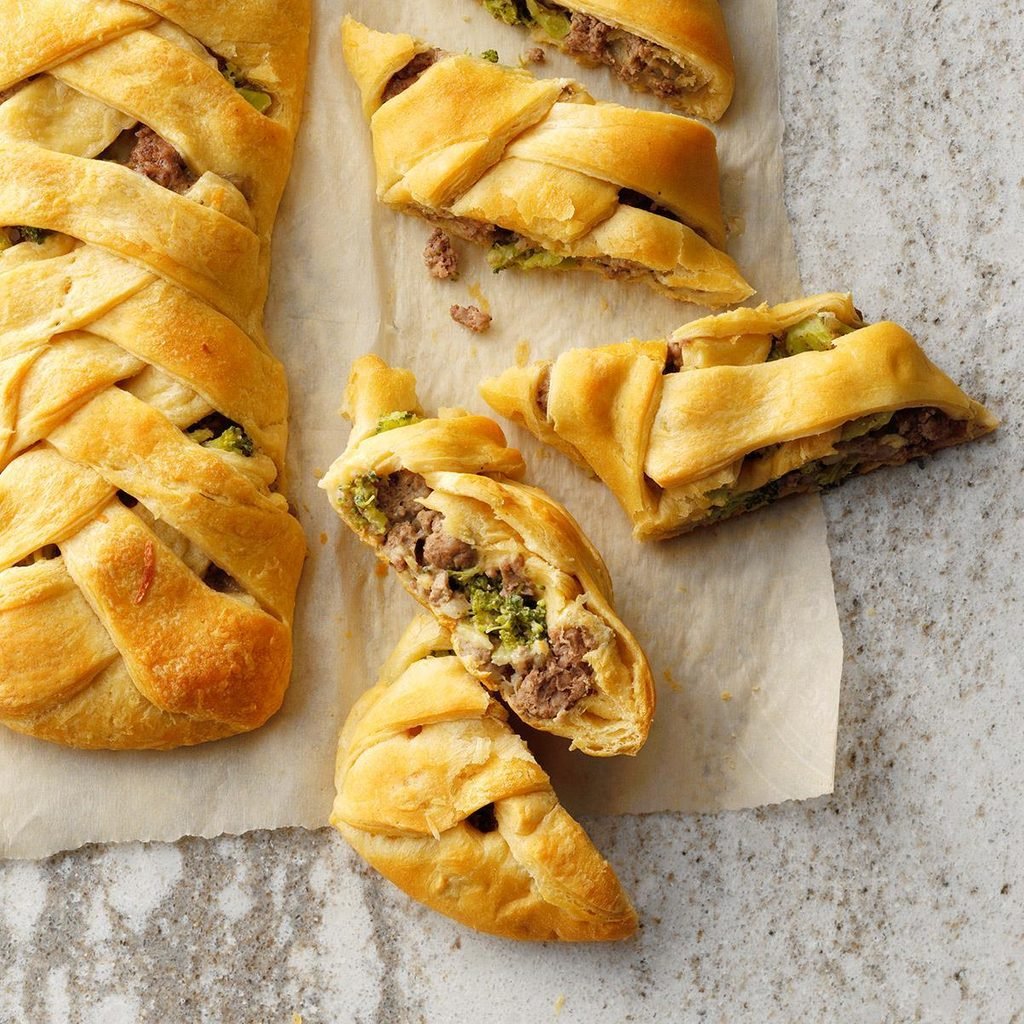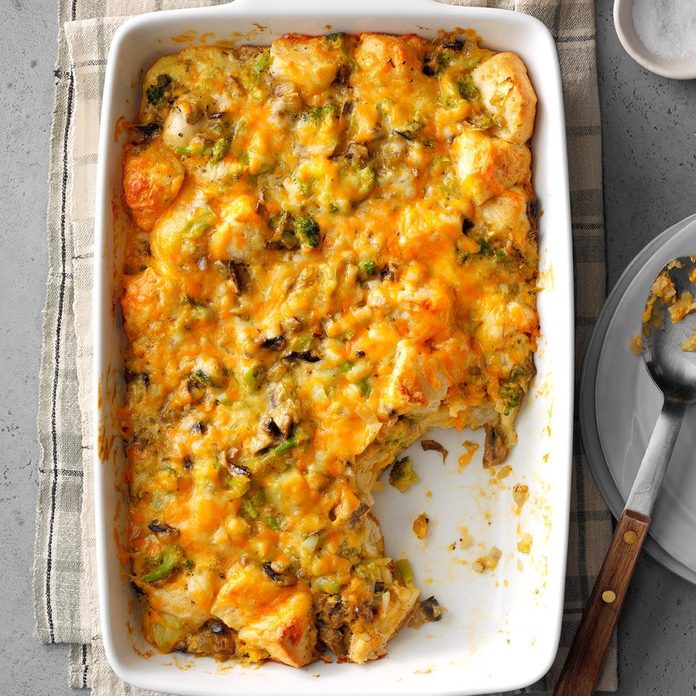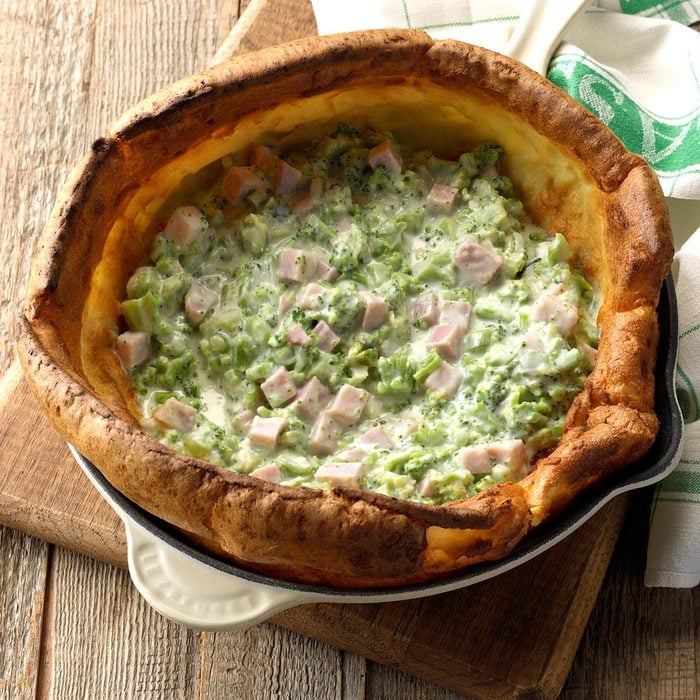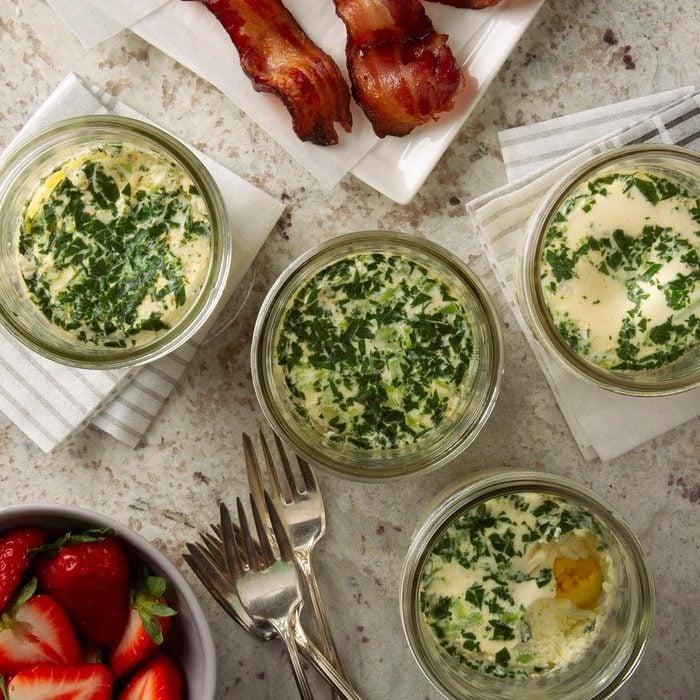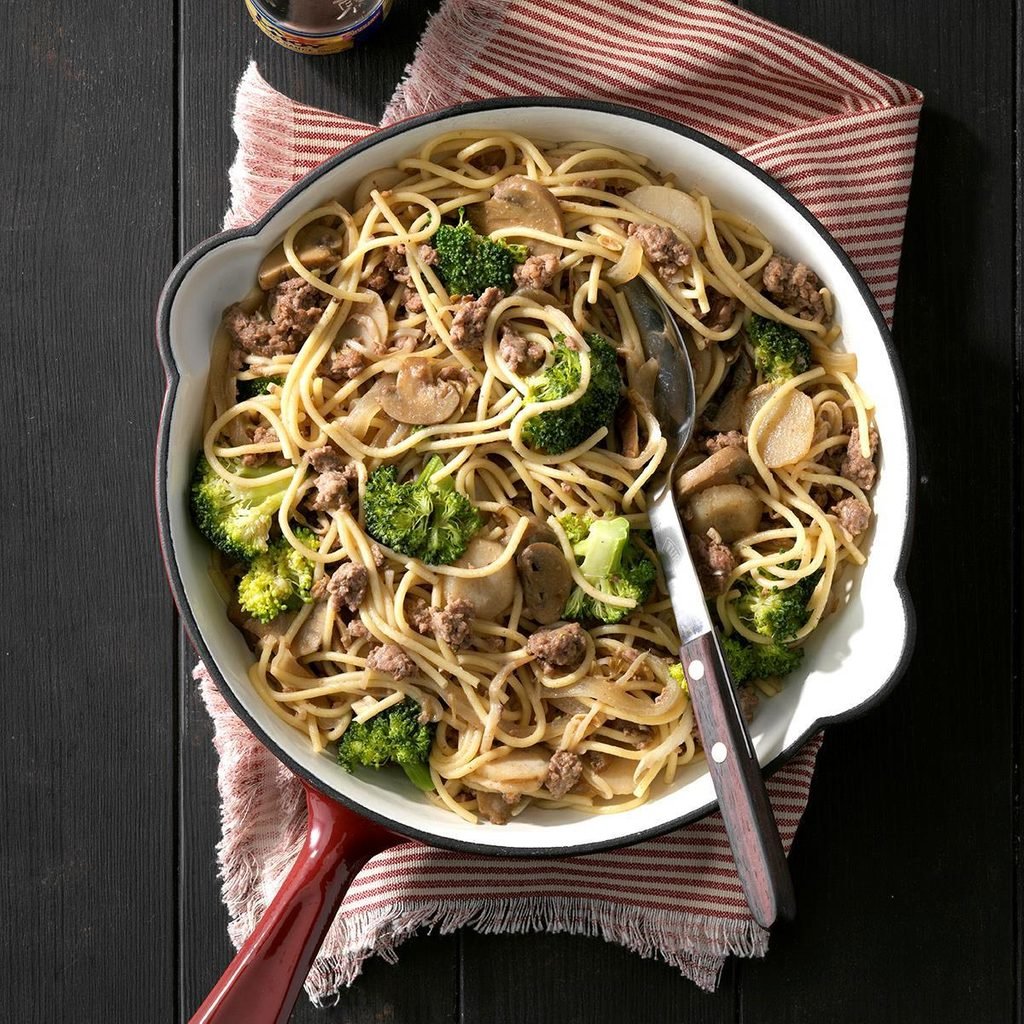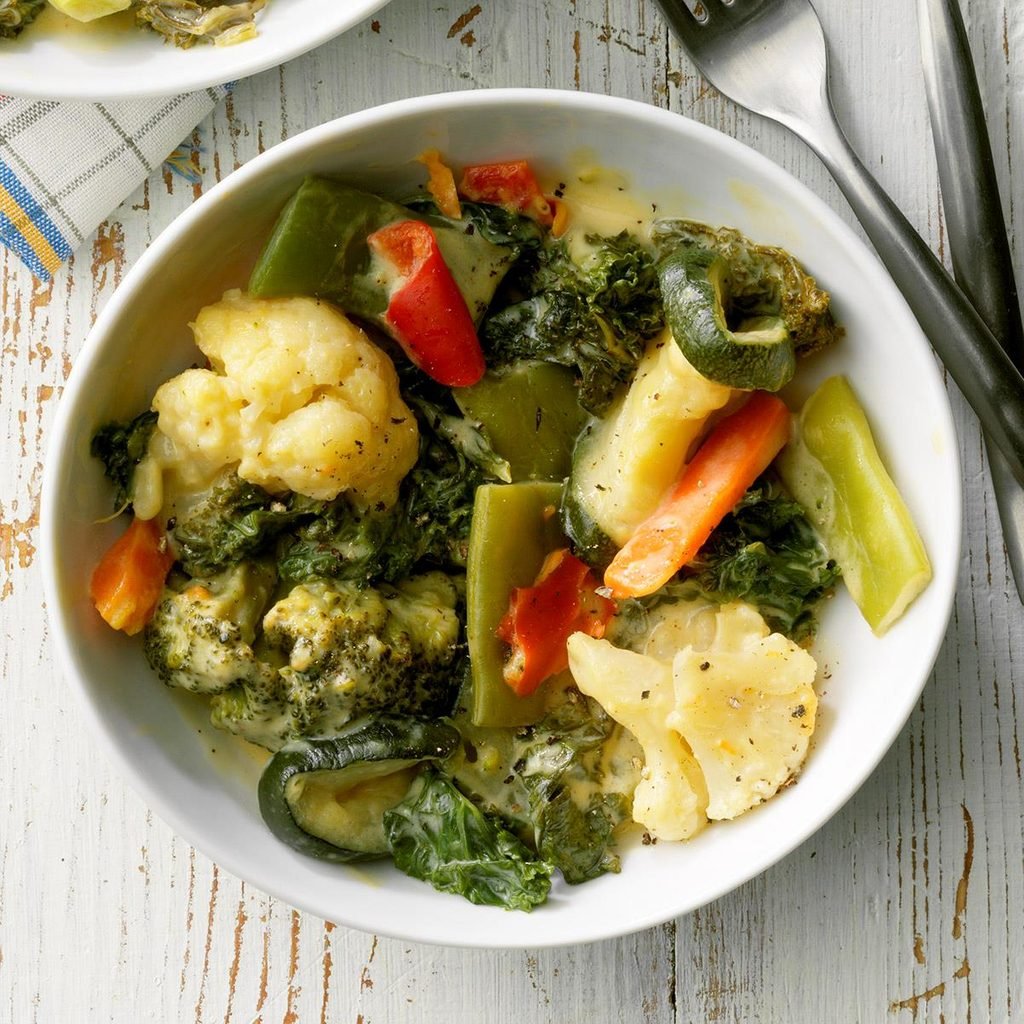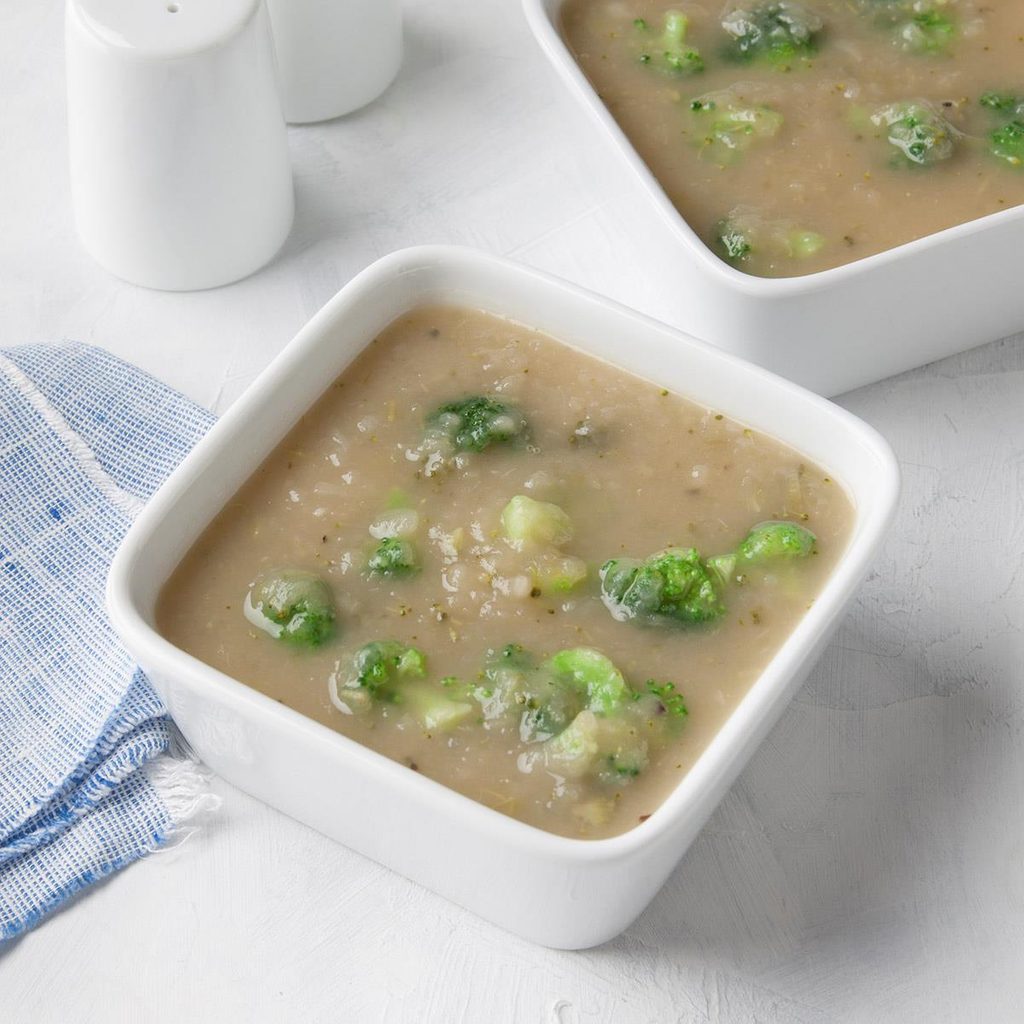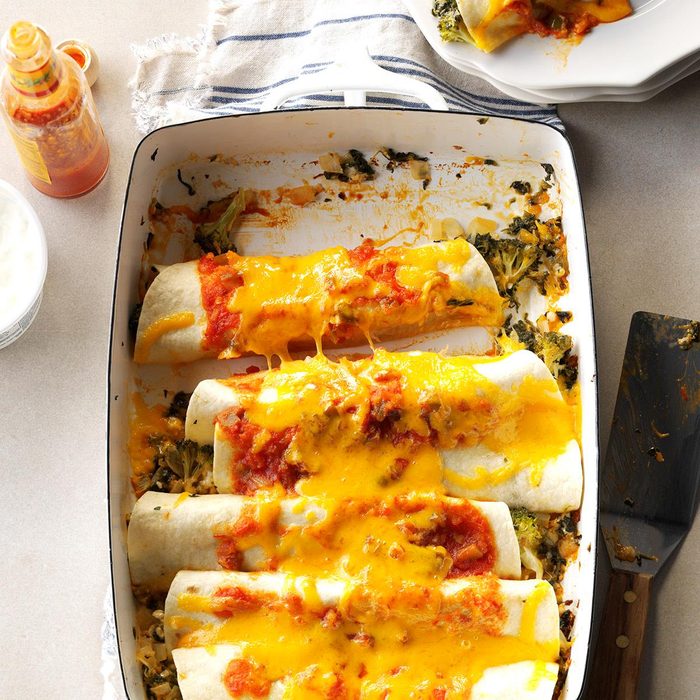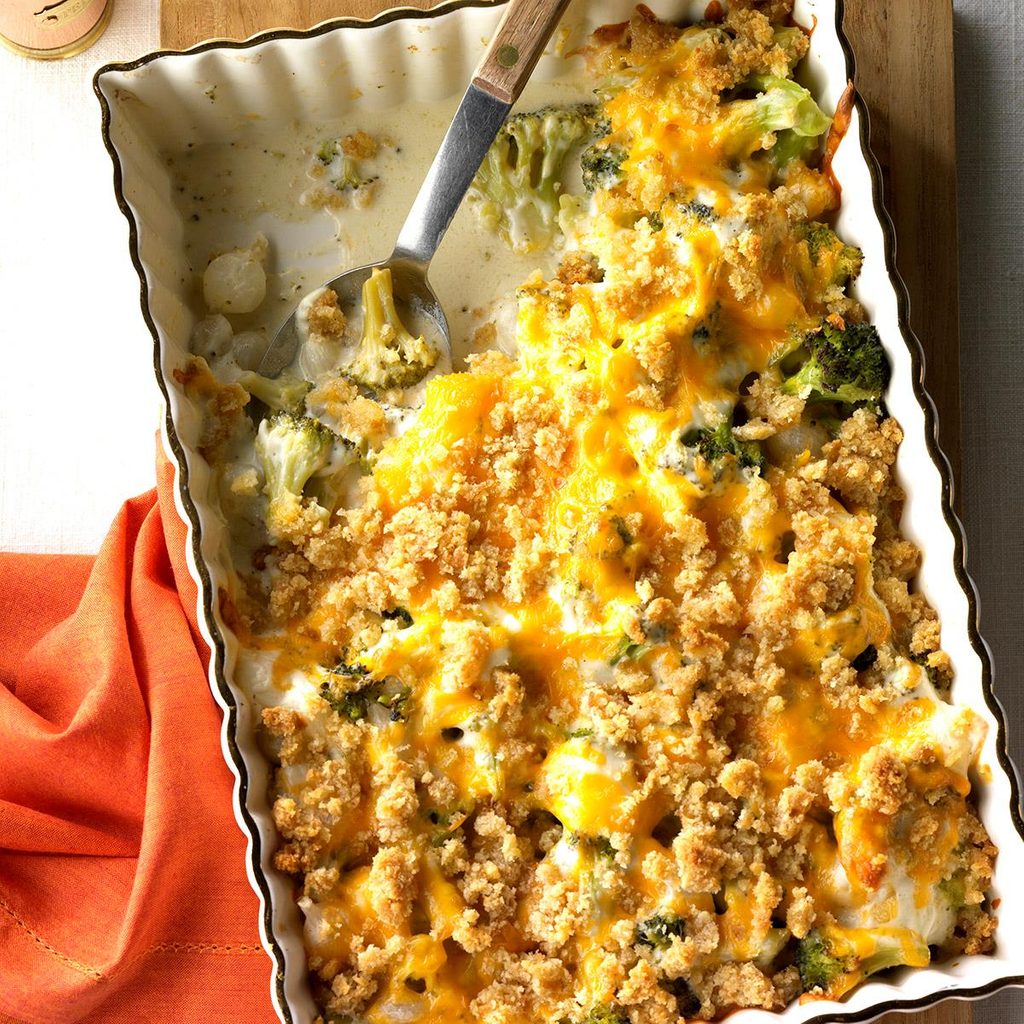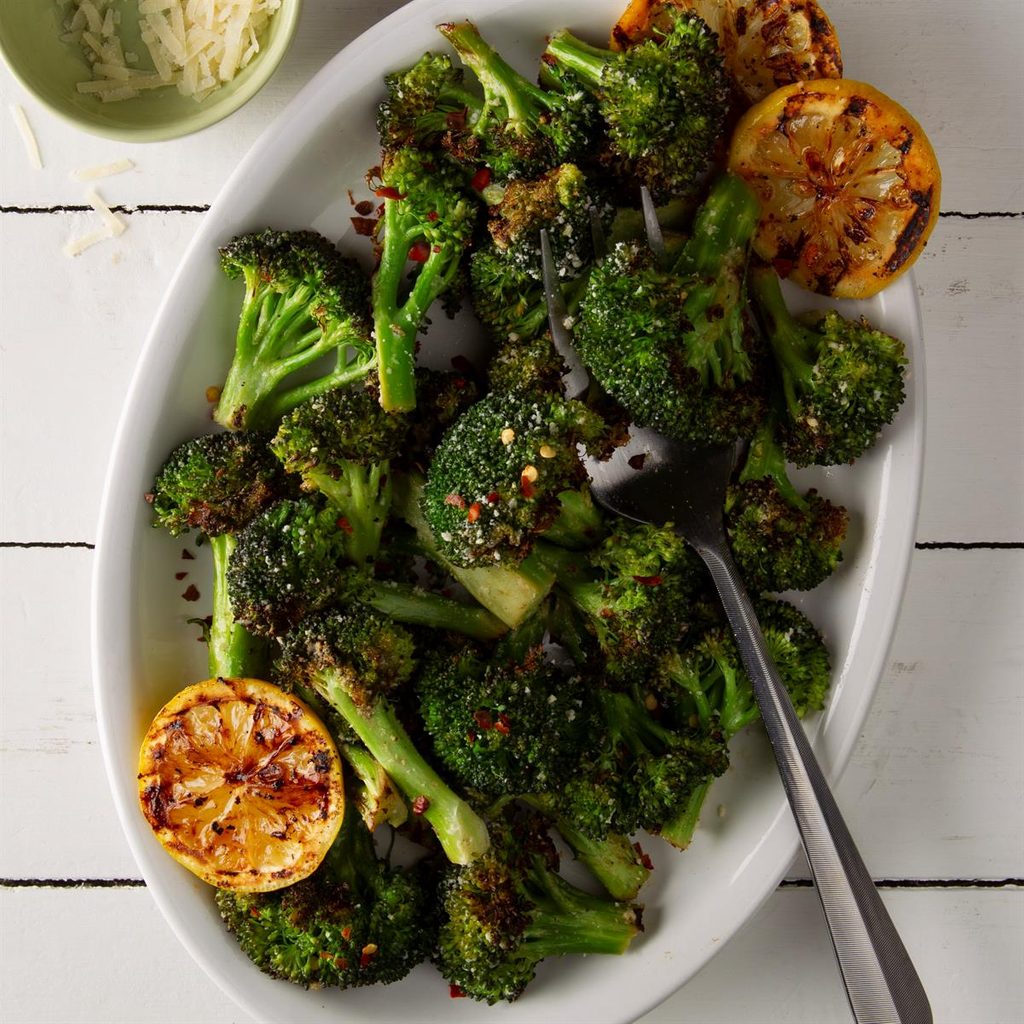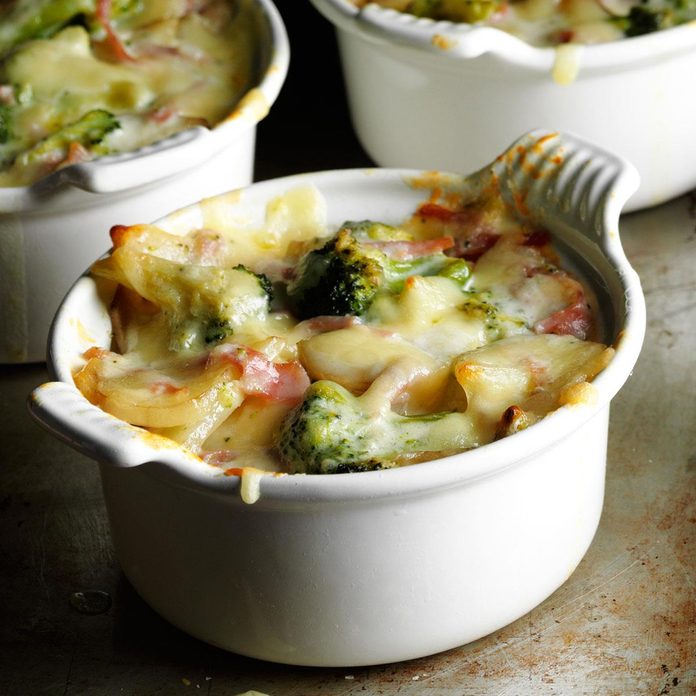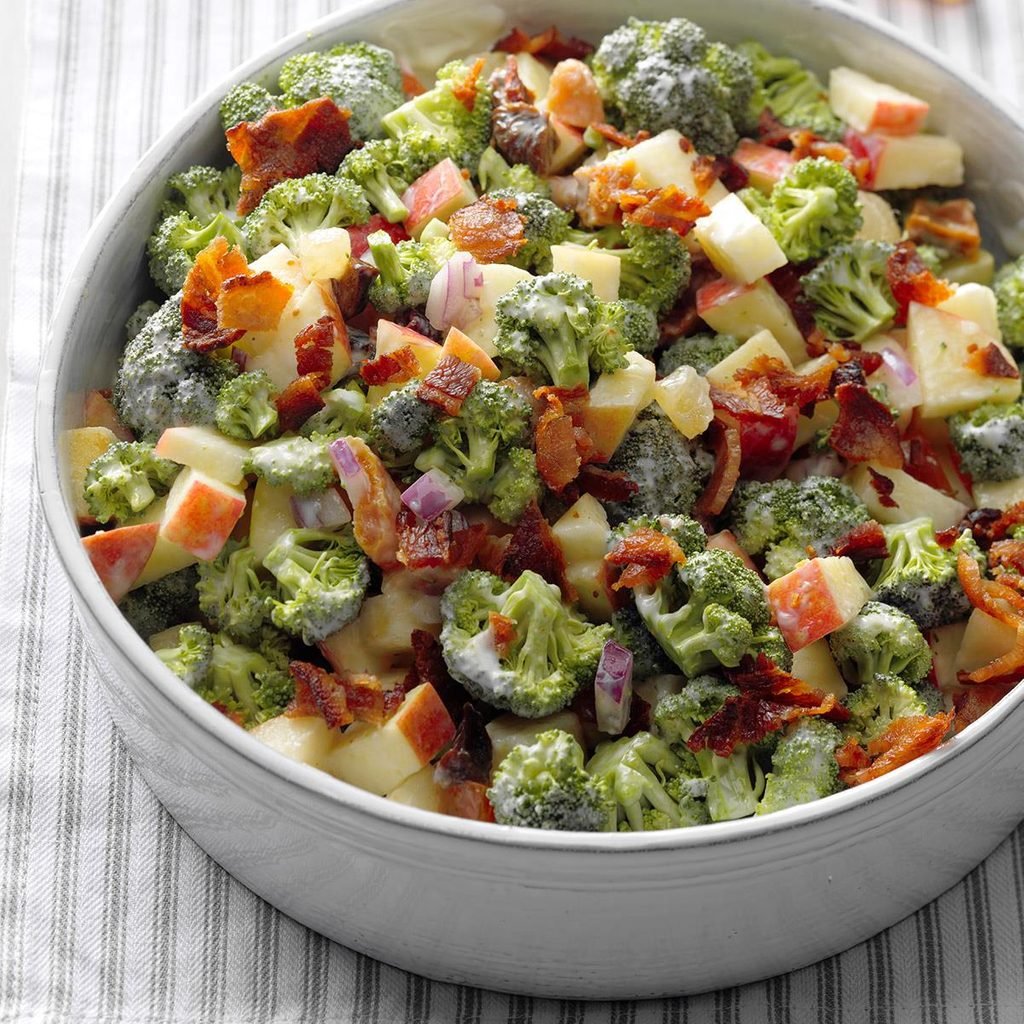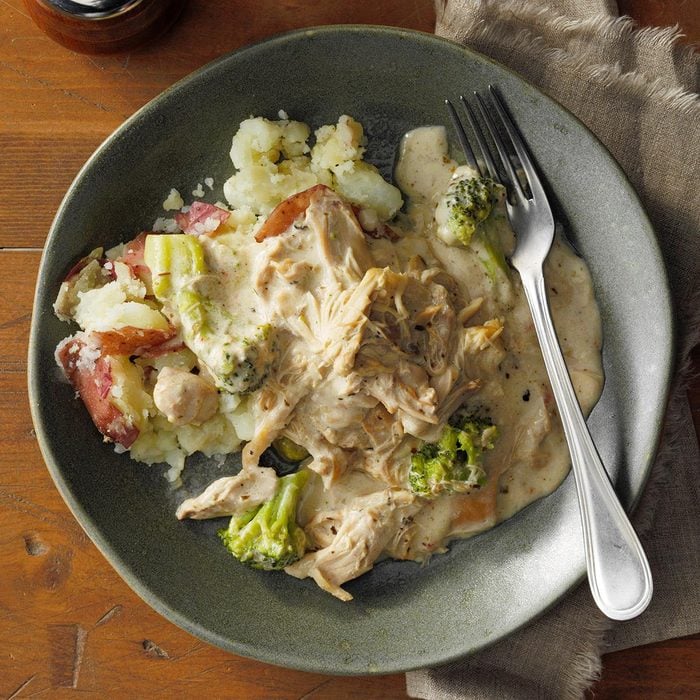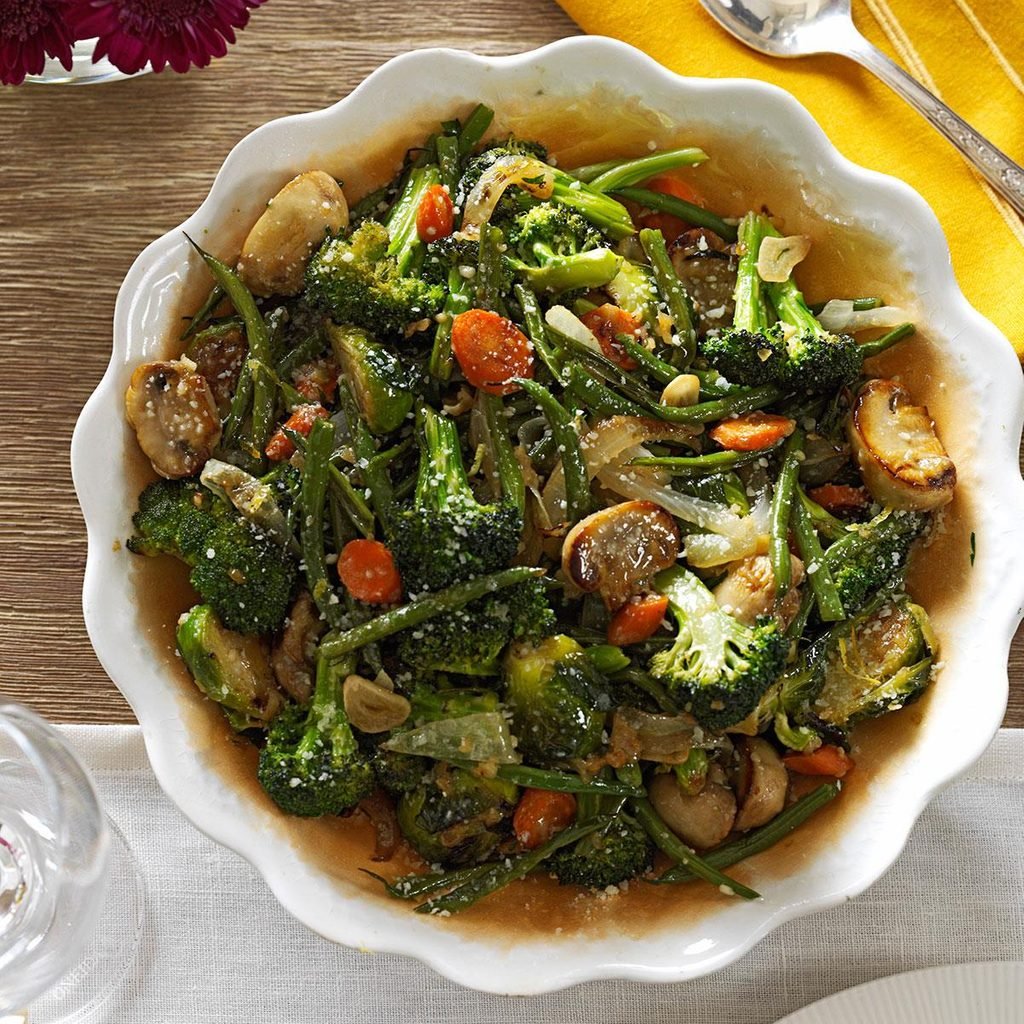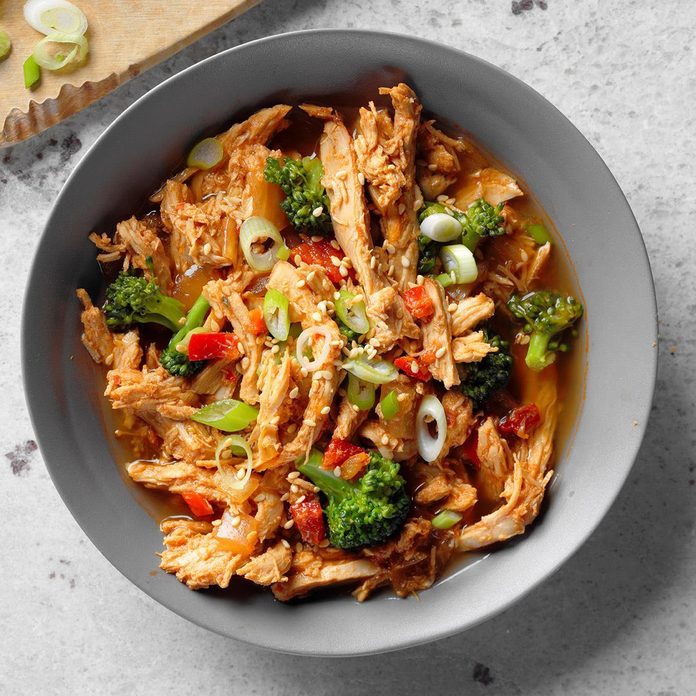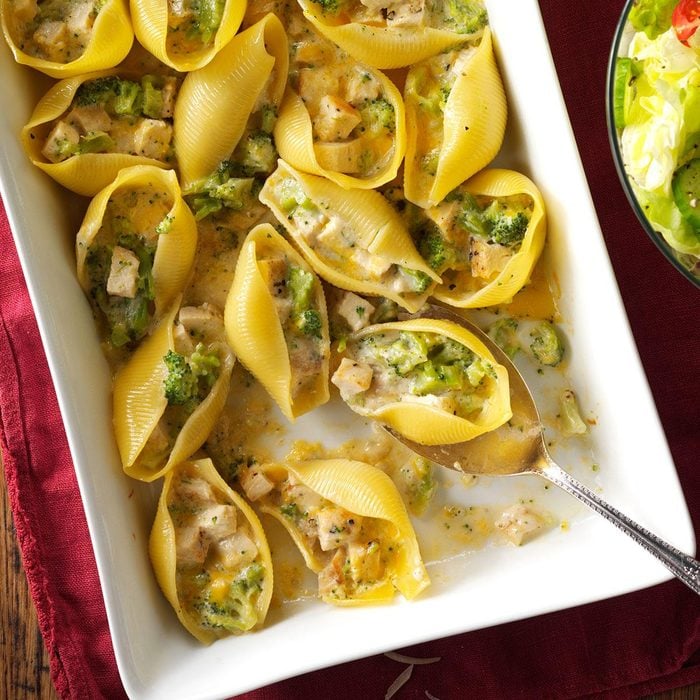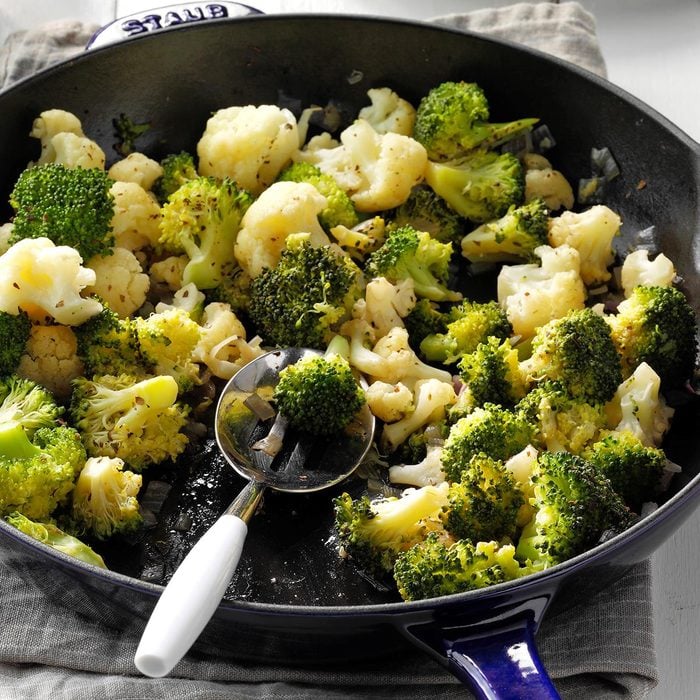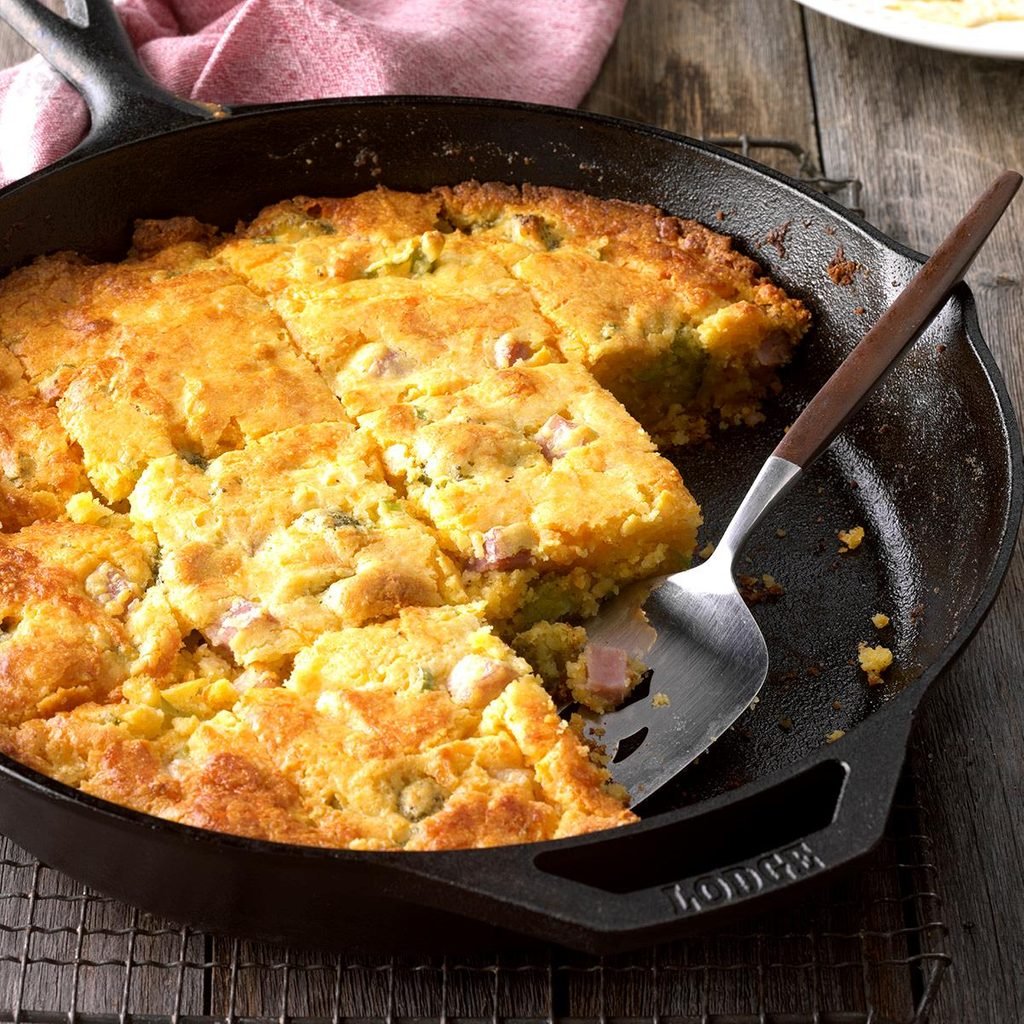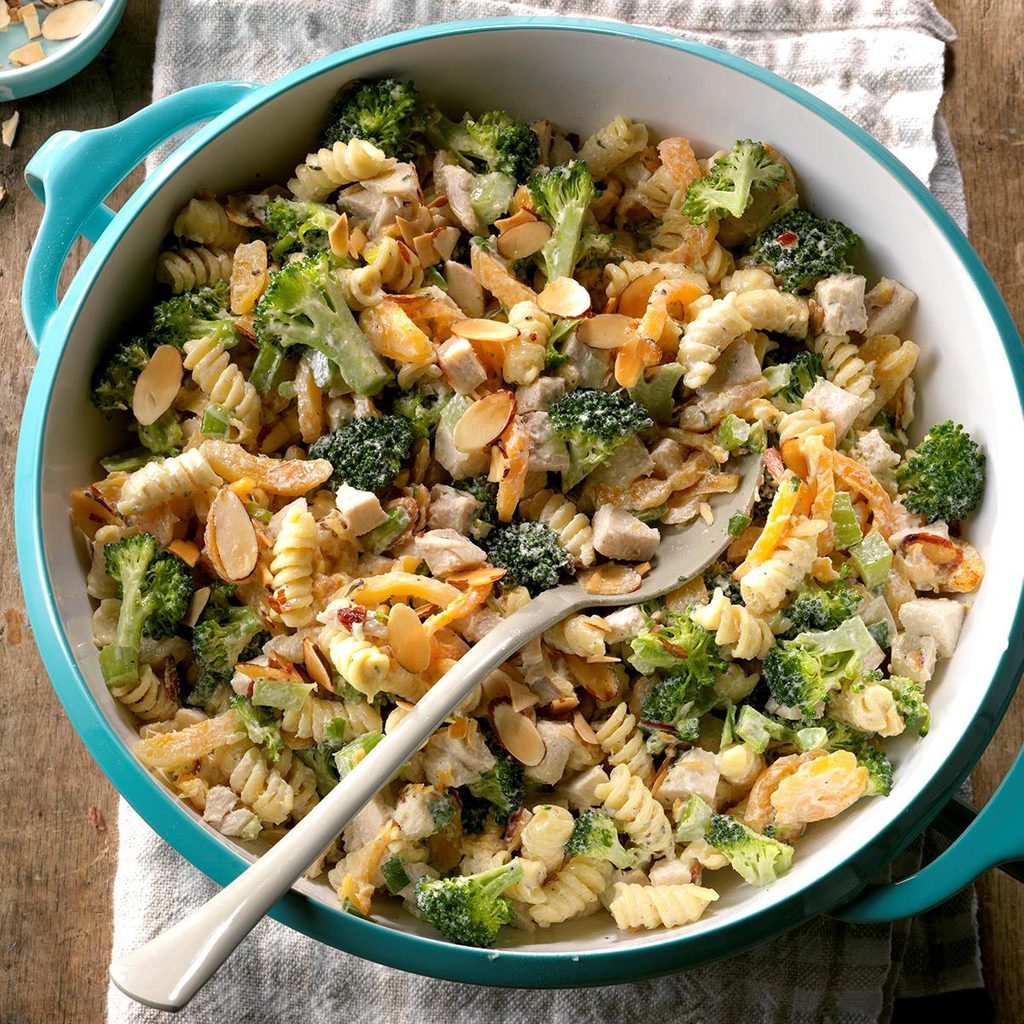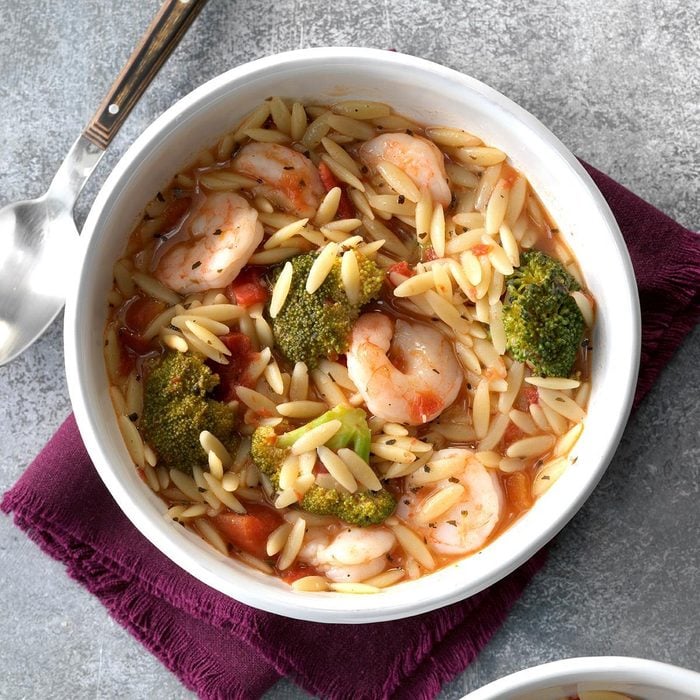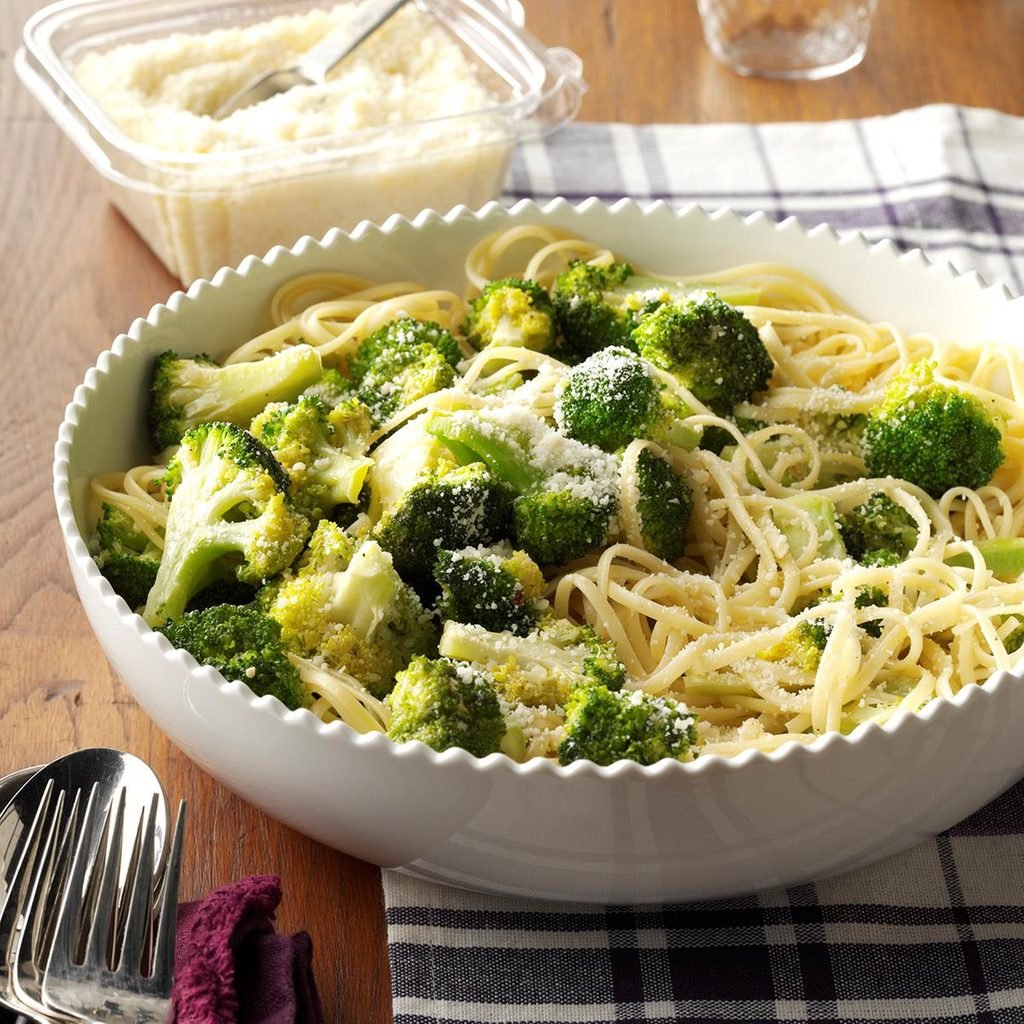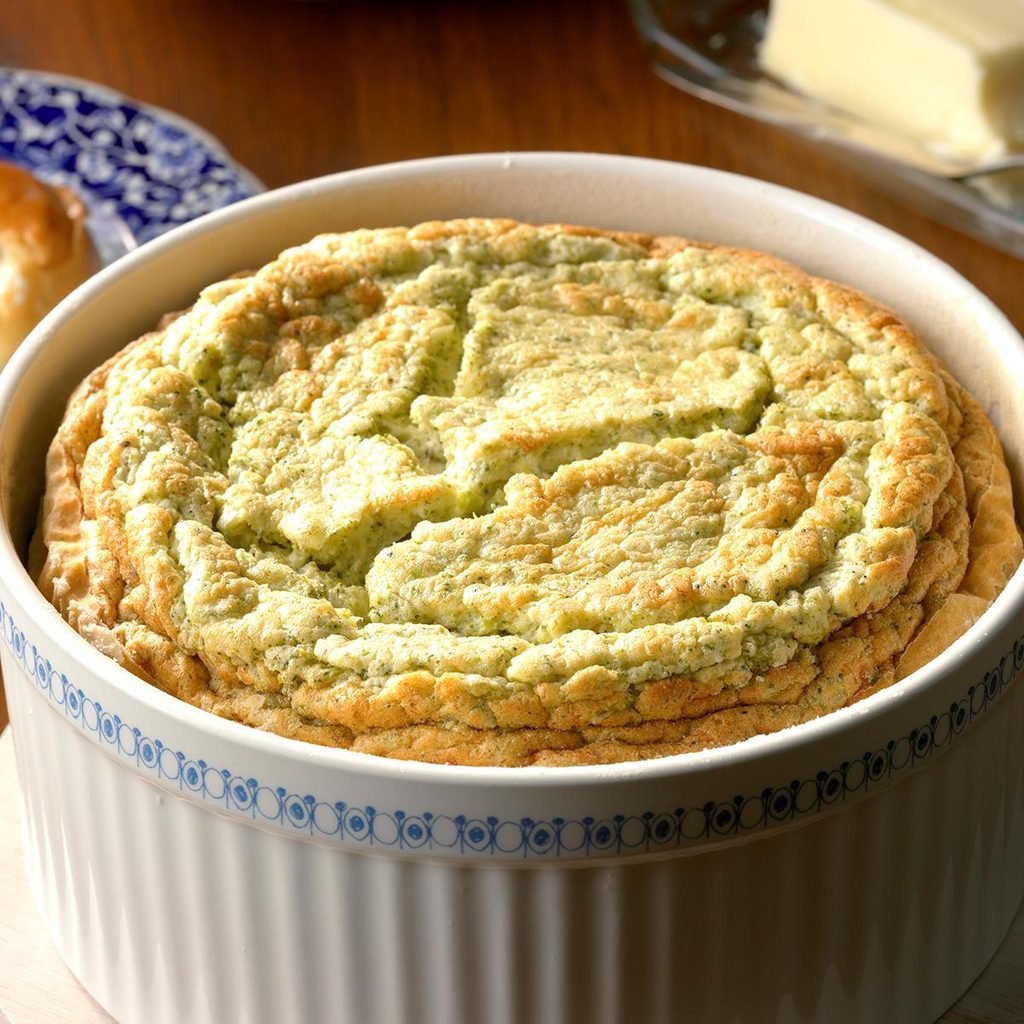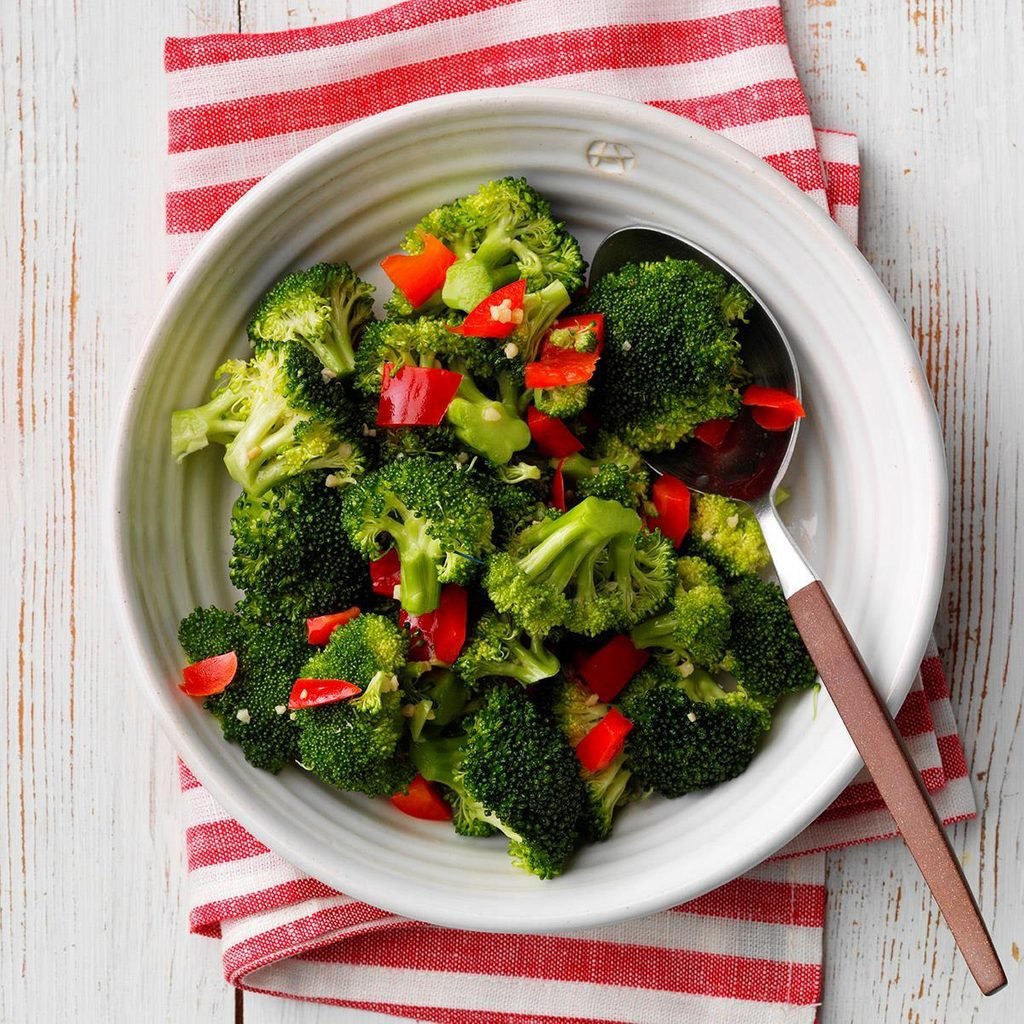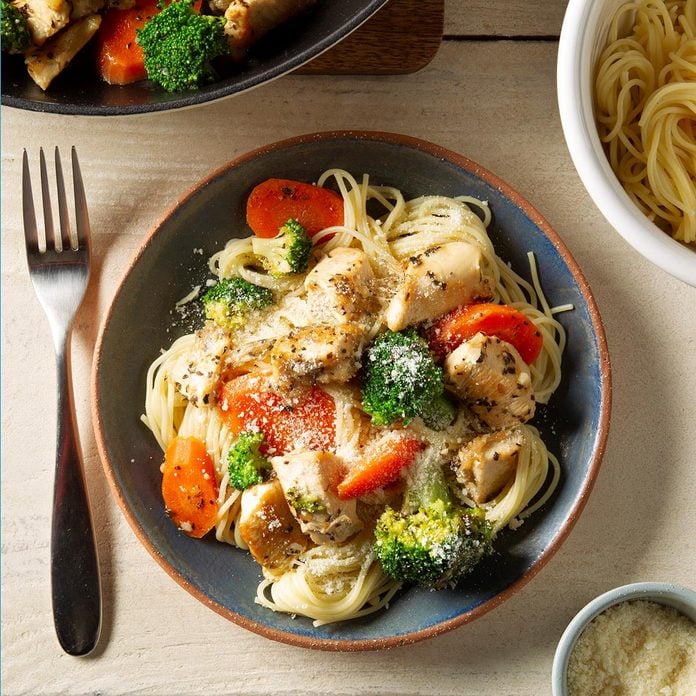Nutty Broccoli Slaw
My daughter gave me the recipe for this delightful salad. The sweet dressing nicely coats a crisp blend of broccoli slaw mix, onions, almonds and sunflower kernels. Crushed ramen noodles provide even more crunch. It's a smash hit wherever I take it. —Dora Mae Clapsaddle, Kensington, Ohio
Get Recipe
Contest-Winning Broccoli Chicken CasseroleThis delicious chicken and broccoli casserole recipe is a twist on chicken divan that came from an old boss. It’s quick, satisfying comfort food. —Jennifer Schlachter, Big Rock, Illinois
Broccoli Shrimp AlfredoAfter tasting fettuccine Alfredo at a restaurant, I came up with this shrimp Alfredo with broccoli version at home. Not only does my family love the creamy dish, but my husband prefers it to the one at the restaurant. —Rae Natoli, Kingston, New York
Beef Broccoli Stir-FryMy family often requests this tasty beef and broccoli stir fry. It's great because it combines tender beef and nutritious vegetables in one dish. We enjoy this broccoli beef recipe year-round but especially in summer, when I grow my own broccoli and onions. Plus, it doesn't heat up the kitchen. —Ruth Stahl, Shepherd, Montana
Broccoli Cheddar SoupMy husband and I love this cheesy dish. It is proof that soup doesn't need to be made in big batches to be good. —Cheryl McRae, West Valley, Utah
Chicken and Swiss Stuffing BakeI love to cook but just don't have much time. This casserole is both comforting and fast, which makes it my favorite kind of recipe. I serve it with a green salad. —Jena Coffey, Sunset Hills, Missouri
Parmesan Roasted BroccoliSure, it’s simple and healthy but, oh, this roasted broccoli is also delicious. Cutting the stalks into tall trees turns the ordinary veggie into a standout side dish. —Holly Sander, Lake Mary, Florida
Broccoli Mac & Cheese BakeMy husband made a version of this casserole for me on our first date. Over the 11 years we’ve been married, we’ve made
several changes to the
ingredients and now it’s even better than the original. —Lisa DeMarsh, Mount Solon, Virginia
Lemon Couscous with BroccoliI combined two recipes to create this side with broccoli and pasta. The splash of lemon adds nice flavor. Instead of toasted almonds, you could also sprinkle servings with grated Parmesan cheese. —Beth Dauenhauer, Pueblo, Colorado
Sausage French Bread PizzaI never seem to have pizza dough on hand, but that doesn't ever stop our family from enjoying pizza. We top crusty French bread with creamy Alfredo sauce, sausage and veggies. It's great to serve at a party for children or teens. —Cherie Sweet, Evansville, Indiana
Ham and Broccoli Baked PotatoesThis loaded baked potato dish is a spin on a favorite family recipe I have made for years: ham and potato casserole. It's a great recipe when you have a tight food budget, and it tastes amazing! The potatoes and filling can be prepared ahead of time, then assembled prior to serving. —Patricia Prescott, Manchester, New Hampshire
Broccoli Tuna CasseroleWhen I was in the Navy, a co-worker's wife shared this recipe with me. I’ve tweaked it over the years, but it still brings back memories of my "family" away from home. —Yvonne Cook, Haskins, Ohio
Sheet-Pan Chicken ParmesanSaucy chicken, melty mozzarella and crisp-tender broccoli—all in one pan. What could be better? —Becky Hardin, St. Peters, Missouri
Corn and Broccoli in Cheese SauceSave room in the oven by making this savory side in your slow cooker. It is a standby in my house. My daughter likes to add leftover ham to create a hearty main course. —Joyce Johnson, Uniontown, Ohio
Loaded Broccoli-Cheese Potato ChowderFor anyone who loves baked potatoes or broccoli cheese soup, this is the best of both worlds. If you have bacon lovers, offer crumbled cooked bacon as a topping. Then everyone is happy, carnivore or not! —Vivi Taylor, Middleburg, Florida
Chicken Biscuit BakeGolden biscuits cover this homespun dish laden with chicken, broccoli and cheese. It's then topped with a celery seed mixture. My family requests this all-in-one dinner once a month. —Karen Weirick, Bourbon, Indiana
Sunflower Broccoli SaladThis crisp salad is so refreshing that we always eat every bit. —Marilyn Newcomer, Sun City, California
Broccoli Beef BraidsEach slice of this fast-to-fix golden bread is like a hot sandwich packed with beef, broccoli and mozzarella. —Penny Lapp, North Royalton, Ohio
Broccoli-Mushroom Bubble BakeI got bored with the same old breakfast casseroles served at our monthly moms' meeting, so I decided to create something new. Judging by the reactions of the other moms, this one's a keeper. —Shannon Koene, Blacksburg, Virginia
Broccoli-Ham Puff PancakeWe like to use our heirloom cast-iron skillet to make this Sunday special. The golden brown puff pancake with a creamy ham and broccoli filling makes a tasty main dish for brunch.—Edna Hoffman, Hebron, Indiana
Pressure-Cooked Broccoli Egg CupsServing brunch? These delicious Instant Pot egg cups are filled with crunchy bites of broccoli and served in ramekins. I promise your company will love this tasty recipe! —Edna Hoffman, Hebron, Indiana
Cheesy Cheddar Broccoli CasseroleEven people who don’t like broccoli beg me to make this comforting broccoli cheese casserole recipe. It's similar to a classic green bean casserole, but the melted cheese just puts it over the top. —Elaine Hubbard, Pocono Lake, Pennsylvania
Mediterranean Broccoli & Cheese OmeletMy Italian mother-in-law taught me to make this omelet years ago—she would make it for breakfast, lunch or dinner and eat it on Italian bread. This is one of my favorite ways to use up leftover broccoli. —Mary Licata, Pembroke Pines, Florida
Broccoli Beef Lo MeinMy family loves pasta, but I'm always looking for different ways to prepare it. This dish is better than any Chinese restaurant variety I've tried.—Joan Crandall, Burlington, Connecticut
Slow-Cooked Vegetables with Cheese SauceWho can pass up veggies smothered in cheese? No one I know! This is an inviting recipe to serve kids who normally shy away from vegetables.
—Teresa Flowers, Sacramento, CA
Vegan Cream of Broccoli SoupPureed potatoes help give this vegan cream of broccoli soup a silky texture without the cream! This is a fantastic trick to make dairy-free soups super creamy. —Taste of Home Test Kitchen, Milwaukee, Wisconsin
Spinach 'n' Broccoli EnchiladasI like to top this wonderful meatless meal with lettuce and serve it with extra picante sauce. It's quick, easy, filled with fresh flavor and definitely satisfying! —Lesley Tragesser, Charleston, Missouri
Pearl Onion Broccoli BakeWith its creamy white cheese sauce and buttery crumb topping, this dish is great comfort food. If you’re looking for a mild way to dress up broccoli, this is the recipe. —Charles Keating, Manchester, Maryland
Fresh Broccoli Salad with LemonThe slightly sweet flavor of this salad's dressing is a great contrast to the rich bacon. You can substitute cauliflower for the broccoli if you prefer. —Janet Roth, Tempe, Arizona
Grilled BroccoliI started using this recipe in 1987, when I began cooking light, and it's been a favorite side dish ever since. With its lemon and Parmesan flavors, it once took second place in a cooking contest. —Alice Nulle, Woodstock, Illinois
Broccoli Scalloped PotatoesThe combination of ham and cheese creates a wonderfully smoky flavor. I also love that I can cook an entire meal—vegetable and all—in one standout dish. —Denell Syslo, Fullerton, Nebraska
Broccoli and Apple SaladEven my picky daughter loves this one! My yogurt dressing on crunchy veggie salad makes a cool and creamy side dish. —Lynn Cluff, Littlefield, Arizona
Creamy Chicken & Broccoli StewShh! Don’t tell anyone! This recipe is so simple, but you’d never know it. My husband, who normally doesn’t like chicken, asks for this dish regularly. —Mary Watkins, Little Elm, Texas
Roasted Green Vegetable MedleyRoasting vegetables such as broccoli, green beans and Brussels sprouts is a fantastic way to serve them, and almost any veggie combo works. — Suzan Crouch, Grand Prairie, Texas
General Tso’s StewI love Asian food and wanted a chili-like soup with the distinctive flavors of General Tso’s chicken. The slow cooker makes this super easy, and you can use any meat you like. It’s a great with turkey, ground meats or leftover pork. —Lori McLain, Denton, Texas
Broccoli Ham QuicheThis rich ham and broccoli quiche is featured in a family cookbook I put together. My husband is proof that quiche can satisfy even a very healthy appetite. —Marilyn Day, North Fort Myers, Florida
Chicken Broccoli ShellsThis cheesy entree is a make-ahead dream. Just assemble it ahead of time and put it in the oven when company arrives. I round out the meal with a tossed salad and warm bread. —Karen Jagger, Columbia City, Indiana
Broccoli-Cheddar Beef RollsMy grandma's recipe for beef rolls is easy to change up. Load them with ham, veggies, or even olives, as you like! —Kent Call, Riverside, Utah
Broccoli-Pork Stir-Fry with NoodlesI combined several recipes to come up with this dish that my family loves. It is not only quick and delicious but also healthy. I sometimes substitute boneless, skinless chicken breasts for the pork. —Joan Hallford, North Richland Hills, Texas
Broccoli Cauliflower ComboShallots, basil and broth rev up the taste of this nutritious vegetable medley. The bright color and fresh flavors will dress up your plate! —Clara Coulston, Washington Court House, Ohio.
Broccoli Quiche CupsMake this crustless quiche in muffin cups or in a regular-size pie tin. Either way, there's plenty of bacon-y, cheesy goodness to go around. —Angela Lively, Conroe, Texas
Ham and Broccoli CornbreadLeftovers haunt me. Often nobody wants to eat them, and I hate to see them go to waste. A cornbread casserole is an excellent way to leverage many combinations of leftover meat and veggies into exciting new meals that everyone will love. —Fay Moreland, Wichita Falls, Texas
Almond-Apricot Chicken SaladHere's a one-of-a-kind pasta salad that combines tender chicken, sweet apricots and crunchy vegetables. Plus, the lemony dressing can't be beat. —Susan Voigt, Plymouth, Minnesota
Orzo Shrimp StewMy husband and I really enjoy seafood, so I don’t skimp on shrimp in this mildly seasoned stew. We also adore the broccoli, tomatoes and pasta. —Lisa Stinger, Hamilton, New Jersey
Broccoli-Pasta Side DishI love to fix new recipes for my husband, Robert, and our children. With garlic and cheese, this broccoli pasta is a tasty way to get kids to eat their veggies. —Judi Lacourse, Mesa, Arizona
Royal Broccoli SouffleTalk about impressive! This side dish never fails to impress even the toughest of critics--my family. —Linda Evancoe-Coble, Leola, Pennsylvania
Marinated BroccoliThis festive side dish couldn't be easier to throw together. But because it's so pretty, it's perfect for special occasions. —Edna Hoffman, Hebron, Indiana
Angel Hair Pasta with ChickenIf you want to put something on the table that’ll give you time to spare on busy nights, give this delicious angel hair pasta with chicken a try. From start to finish, you’re only 20 minutes away from a vibrantly colored meal! —Margaret Wilson, Sun City, California
Slow-Cooked BroccoliThis family-favorite side dish is quick to fix and full of flavor. Because it simmers in a slow cooker, it frees up my oven for other things. That's a tremendous help when I'm prepping a big meal at home. —Connie Slocum, Antioch, Tennessee


